Search Engine Optimization is one of the most(if not the most) intriguing branches of digital marketing. After all, I am not the only one who wants to appear on the first page of Google. Who doesn’t? But, is there a secret hack that you can use to rank #1 on Google?
In this blog, we will not only discuss what search engine optimization really is, but I will also share actionable steps that you can follow to start doing your website’s SEO.
What Is SEO?
Search Engine Optimization is the practice of optimizing your website, so search engines( mostly Google) identify it as a reliable source of information. The result?
Your website ranks on the first page of Google.
But, what’s the point? Why bother about being #1 or even among the top #3 search results?
In 2022, Backlinko(one of the most reliable sources of SEO-related information on the internet) studied about 4 million search results to understand the importance of organic growth strategies.
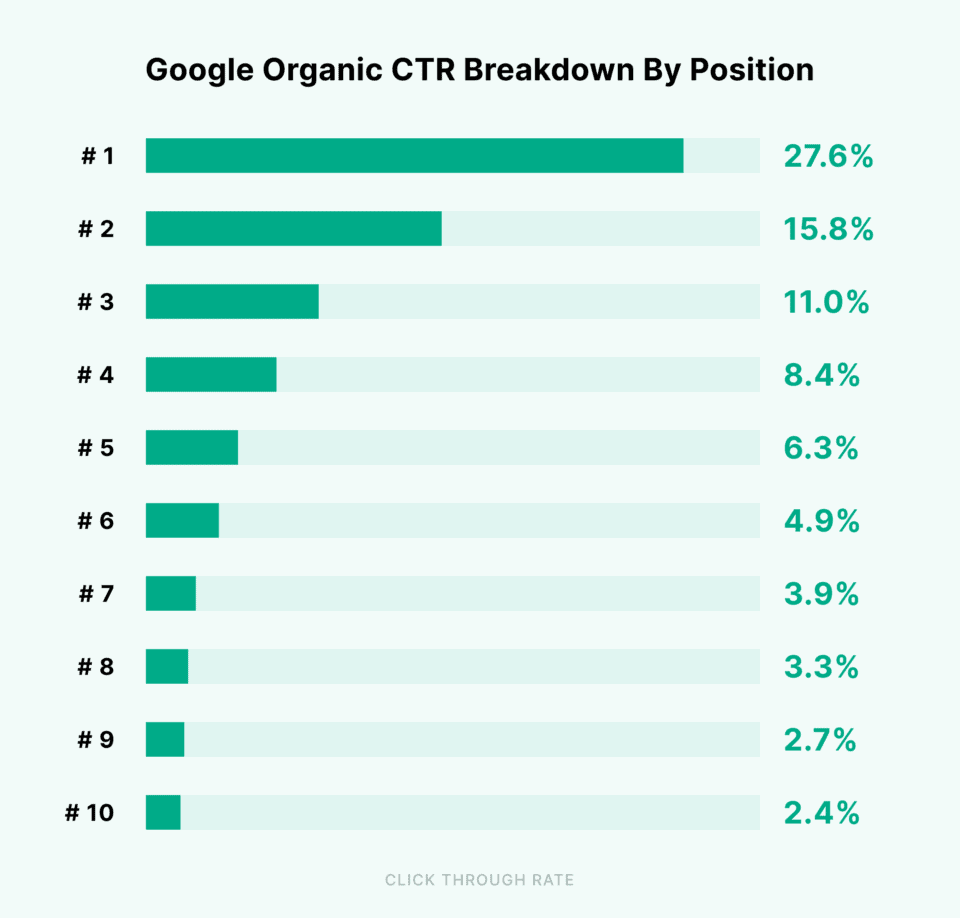
Here’s what they found out:
- The page that ranks number 1 on Google is ten times more likely to get clicked than the one that ranks in the tenth position.
- The average Click-Through-Rate of a page that ranks number 1 on Google is about 27.6%
That means that 27% of all people that search for a particular query don’t go beyond the first page on the SERP(Search Engine Results Pages).
A website that ranks #1 on Google for a particular search term(also called keyword) receives 25% of the total traffic generated by that search term.
That’s not all.
According to an Ahrefs study, pages ranking #1 typically rank in the top 10 for nearly 1,000 related keywords.
That is why SEO matters.
Search Engine Optimization is the art of improving your site’s rankability on Google. How do you do that?
- Publishing high-quality content
- Optimizing your content so it ranks on a specific keyword(or keywords)
- Improving the UX(user experience) of your website
- Making sure that your website doesn’t take too long to load
- Regularly updating your content
- Improving your website’s credibility and trustworthiness by making backlinks(Google sees a backlink as a vote of confidence for your website.
This infographic by Semrush will help you better understand the who, what, and why of SEO marketing better.
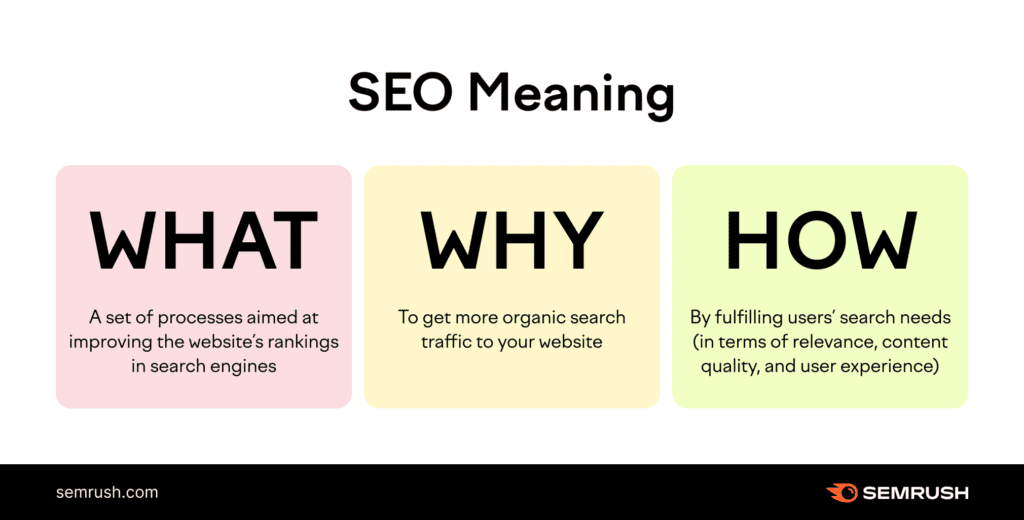
How does search works? Why Do You Need SEO?
Let’s now look into how search works and how to control where your webpage appears on the results page (how to do SEO).
Search engines use software called crawlers or spiders that navigate the web to find new pages on the internet.
After a spider/crawler discovers a new webpage, it then studies the content of that page(text, images, and videos) to determine what it is about.
Google, then, stores that particular page in a database(called Google’s index). This process is called indexing.
When a user searches for something on Google, Google tries to find all the pages stored in their index and arrange them in the order of relevance and helpfulness. The pages that a search engine displays in response to a user’s search query are called Search Engine Results Pages(SERP).
Pages that Google thinks are most likely to answer the searcher’s query usually appear in the top 10 results (the first page of Google).
That’s what SEO is really about.
Yes, there are technical aspects of SEO that deal with improving your site’s speed and user experience. But, at its core, SEO is all about sharing valuable information on the internet so the right people(your target audience) find you and trust you.
Types Of SEO
Now that you know what SEO is, let’s now get into the types of SEO.
In general, there are 3 types of SEO techniques:
- White Hat SEO
- Black Hat SEO
- Grey Hat SEO
1. White Hat SEO
Google has clearly shared the rules that SEO professionals need to follow to win the SEO game and rank at the top of the SERPs.
White Hat SEO involves religiously following Google’s guidelines so your webpage ranks among the top 10 pages on the SERP.
You can check them out here at Google Search Central.
Some examples of White Hat SEO Techniques are:
- Sharing high-quality content
- Regularly updating your content with new information
- Including relevant keywords in your content
- Having a pre-defined content strategy
- Publishing guest posts to boost your website’s credibility(and your online presence)
2. Black Hat SEO
Black Hat SEO is mostly about tricking Search Engines to rank you on the top of the results page.
While Black-Hat techniques can help you rank on top in a very short period of time, if Google catches you(which they most likely will), your website can either be penalized or your ranking will be downgraded immediately.
Examples Of Black-Hat Techniques
- Buying backlinks
- Keyword stuffing: repeating a particular keyword multiple times in an off-putting path
- Showing different versions of a page to readers and search engines
- Publishing plagiarized content
- Making doorway pages (pages that offer no value to visitors and take them to another page)
3. Grey Hat SEO
In simple words, Grey-Hat SEO is mostly about doing what you have to do to rank on Google.
Grey hat SEO involves using search engine optimization (SEO) techniques that are somewhere in between the acceptable white hat techniques and the unacceptable black hat techniques.
Here are some common examples of Grey-Hat SEO Techniques:
- Paying for reviews to boost your ranking
- Building a Private Blog Network(PBN), which is a network of blogs you use to transfer link juice to your website
- Create multiple social media accounts, so you can promote your website on each account
Needless to say, sticking to the rules is what will bring you results in the long run.
But, understanding the difference between these 3 types of SEO can you determine the right strategy for your business. But, there’s another plus point.
Only when you know the rules can you play by them, right? To not use black or grey hat SEO techniques, you first need to understand what they are.
As you scroll through the web, trust me, you will find a billion other types of SEO(orange-hat or blue-hat or green hat).
These are all different variations of the white, black and grey-hat SEO.
Companies and SEOs(Search Engine Optimizers) use these terms to set themselves apart from others and sound smarter than they really are.
The goal of SEO(or your organic growth strategy) is not to outsmart the algorithm, so you can rank on the first page. The purpose of SEO is to improve your website’s ranking by making it as helpful as possible and facilitating a seamless user experience.
4 Types Of SEO Techniques
Now that we have covered the different types Of SEO, let’s now move on to the SEO techniques that you can use to optimize your website and build your presence online.
There are 4 types of SEO techniques or strategies:
- On-Page SEO
- Off-Page SEO
- Technical SEO
- Local SEO
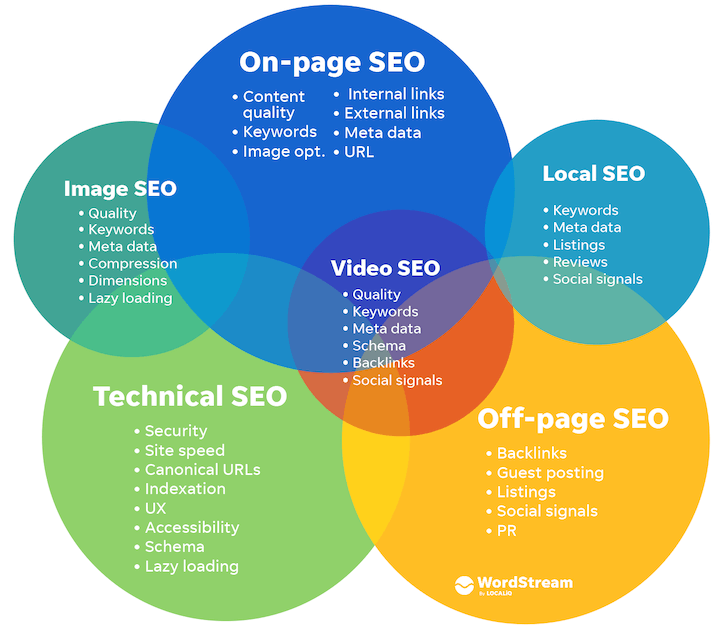
1. On-Page SEO
On-Page SEO involves doing everything that you can do on your website to improve its ranking.
SEO is not about making one big change in your website that will improve its ranking overnight. It involves making small changes regularly so your website eventually becomes the most reliable and helpful resource on the internet about a particular topic.
Some of these changes can be easily done on your website. Others are a bit more complicated.
When you improve your website to make it rank better on Google, it is called “on-page” or “on-site” SEO.
On-page SEO includes (but isn’t limited to):
- Publishing helpful content
- Including relevant keywords in your posts and pages
- Optimizing images
- Including 2-3 internal links on your page
- Using relevant keywords in your anchor text
Let’s dive deeper into on-page SEO:
a) Publishing Helpful Content
The quality of content is what will ultimately determine the fate of your SEO efforts. I’m not kidding. It doesn’t matter how good your website is, if your content isn’t good, you won’t see any results.
But, what qualifies as good or “helpful” content?
And, how can you create it? That’s the diciest part.
Good or helpful content demonstrates “expertise, experience, authority and trustworthiness”. This is what Google calls “EEAT guidelines”.
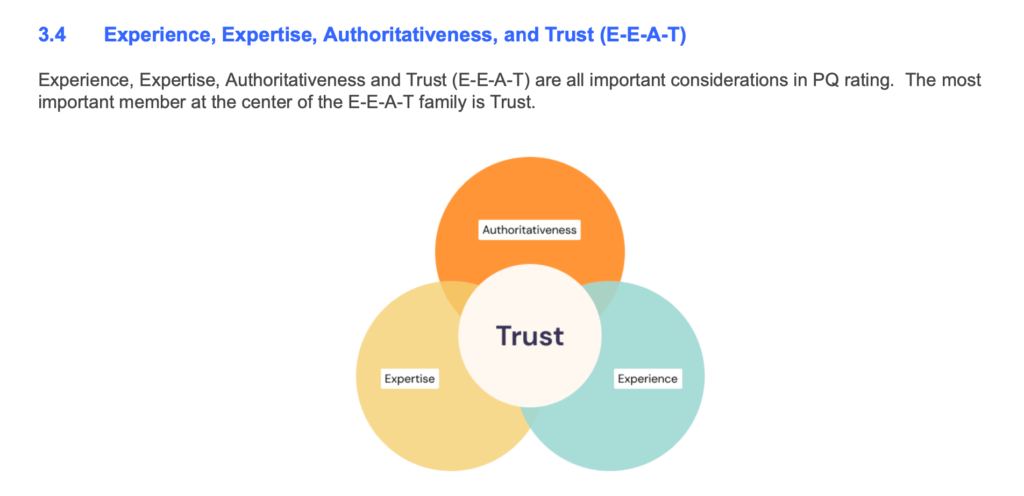
Here are some tips that you can follow to create helpful content:
- Focus on your visitors (What value will they receive from reading your content).
- Being clear is much more important than being creative.
- Address their pain points in your post.
- Use copywriting hooks to write your titles and subheadings. But, please make sure that your titles don’t make promises your content can’t deliver.
- Cite helpful resources and research data.
- Publish original content.
- Don’t just rewrite the information that is already available on the web for free. Always include your individual insights.
- Double-check for factual errors.
- Talk about yourself, especially why people should trust you. What makes you a reliable source of information?
b) Include relevant keywords
Keyword research is an important part of an SEO strategy.
But, what really are keywords?
When a user goes to a search engine(most likely Google) and searches for something, the word(or words) they enter to find what they need are called keywords.
Now, If you have a website that sells coffee tables, you want to find all the keywords people use to look for and buy coffee tables and include them in your content. This is called keyword research.
This way, when someone searches for what you sell(in this case, a coffee table), they see your website in the search results.
Here’s a quick guide to keyword research by Semrush:
Ideally, you want to target keywords with high search volume and low competition (i.e., keywords that many people are entering on Google, but not many competitors are using on their websites). But, it’s not as easy as it sounds.
Here are some tools you can try to do your keyword research:
- Google keyword planner
- Ahrefs keyword generator
- Ahrefs keyword difficulty checker(my personal favourite)
- Moz Keyword Explorer
- Semrush keyword magic tool
Confused? Don’t worry. Here’s a step-by-step guide to keyword research for beginners:
How to do keyword research in 7 simple steps
- Choose a topic or theme that’s relevant to your business or website.
- Use a keyword research tool to come up with a list of keywords and phrases that people might use to search for information related to your topic.
- Look at how many people are searching for each keyword(search volume) and how much competition there is for each one(this is called “keyword difficulty”.)
- Consider using longer, more specific phrases (called “long-tail keywords”) that might be easier to rank for.
- Make sure the keywords you choose fit with what you want to achieve and the content you want to create.
- Look at what kind of content is already ranking for your chosen keywords and try to find ways to provide something unique.
- Use your keyword research to help plan your content strategy, including what topics to cover, how to make your content search engine-friendly, and where to promote your content to get more visibility.
Let’s now move on to the second type of SEO: Off page SEO
2. Off-page SEO
Off-page SEO(also called off-site SEO) involves working outside your website to improve its reputation, authority, and trustworthiness on the internet.
Creating backlinks( links from other websites that point to your websites) is an important part of off-page SEO.
Google sees a backlink as a vote of confidence for a website.
But, the number of backlinks is not the only thing that matters when it comes to off-page SEO.
The quality of the backlinks, as well as the relevancy of the websites that contain those backlinks pointing to your website, and the authority of the specific pages carrying the links, are much more important factors for SEO than the sheer number of backlinks that your website has.
Building high-quality backlinks is essential for improving your website’s search engine rankings and driving traffic to your site.
6 Strategies To Create High-Quality Backlinks
Here are the top 6 backlinking strategies you can use to create high-quality backlinks:
- Creating Linkable Assets: Create high-quality, original content that other websites will want to link to.
- Blogger Outreach: Use outreach and networking to build relationships with other websites in your niche.
- Guest Posting: Publishing content on other relevant websites, and including a backlink to your site in your author bio or within the content itself.
- Online Forum Posting: Participate in online communities and forums related to your niche, and include a link to your site in your forum signature or profile.
- Creating Sharable Content: Create shareable infographics, data visualizations, or other visual content that other websites will want to embed on their pages, with a link to your site.
- Public Relations: Participate in online PR activities and get press coverage or interviews, and ask for a link back to your site in the article or on the interviewer’s website.
3. Technical SEO
Technical SEO is the process of optimizing your website’s infrastructure and fixing technical issues to improve its visibility and ranking on Google.
Just become you have a website, it doesn’t mean that Google will show it in search results(or even add it to its index).
Technical SEO helps your website rank higher on search engines by making it easy for Google to find and index it, while providing a better user experience for visitors.
While I can’t discuss everything there is to know about technical SEO in a single blog post, here’s what you really need to know:
The purpose of technical SEO is to ensure that your website is easily crawlable and indexable by search engines and that it meets their guidelines for things like site speed, mobile-friendliness, and security.
Technical SEO is an ongoing process that requires regular maintenance and monitoring. It’s important to conduct regular audits of your website’s technical elements and fix any issues or errors that could be impacting your search engine ranking.
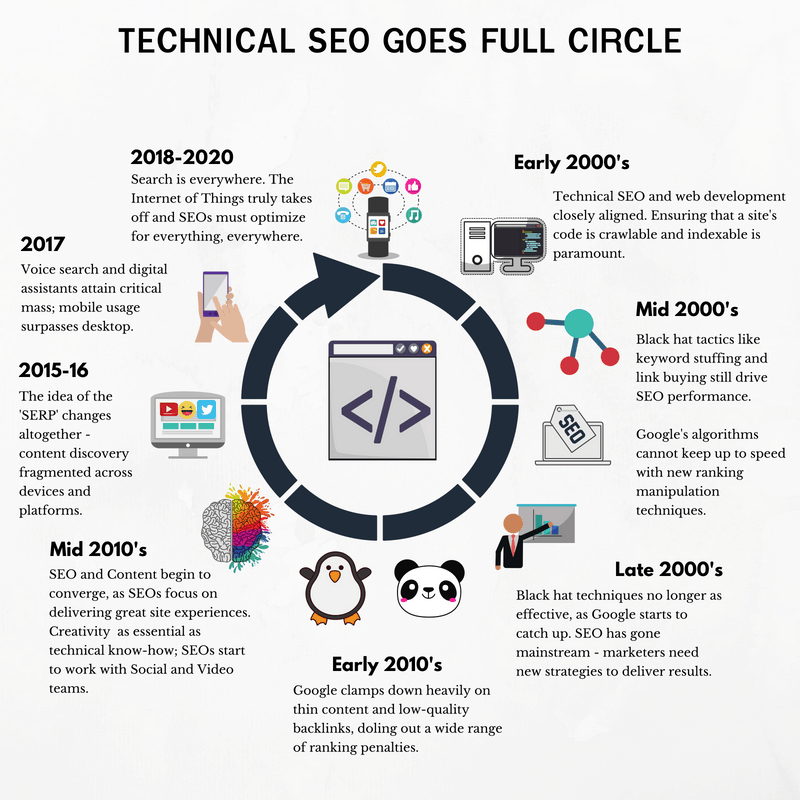
Step-By-Step Guide To Technical SEO For Beginners
- Check your website for any issues or errors that might be impacting its ranking in search results. You can easily use Semrush’s SEO Audit tool for this.
- Optimize your site’s architecture. Make sure your website is easy to navigate and that your pages are organized in a clear and logical way.
- Create simple, easy-to-read web addresses that accurately describe the content on each page.
- Help search engines understand your website’s structure by creating a sitemap.
- Use a robots.txt file to tell search engines which pages they should and shouldn’t crawl.
- Speed up your website’s load times by compressing images and code. If you are using WordPress, you may want to try the Smush image compression plugin for the same. To minify the code of your website, consider using free plugins like W3 Total Cache or Autoptimize.
- Make sure your website is mobile-friendly and works well on smartphones and other mobile devices.
- Ensure your website is secure and uses HTTPS encryption to protect your visitors’ data and privacy.
4. Local SEO
As the name suggests, local SEO is about optimizing your websites for location-specific search queries.
Here’s why local SEO is important:
- Location-based searches account for 30% of all mobile searches.
- 28% of local searches end up in a purchase.
- Within a day of searching for something nearby on their smartphones, 76% of people visit a business.
Source: Ahrefs
Local SEO is what will bring you as close to fulfilling your business goals as you can be.
To start doing local SEO, you first need to claim a business listing on Google. This will help your business appear on Google maps.
Next, you need to optimize your website for location-based keywords.
Try to find as many service-related keywords for your business as you can.
That is always because people don’t always know what they are searching for. But, they always know what they want google to help them with.
Let’s say you run a wedding planning business in Mumbai. Here are some service-related keywords you might use to optimize your website and attract local customers:
- Wedding planners in Mumbai
- Affordable wedding planning services in Mumbai
- Wedding event management companies in Mumbai
- wedding planning in Mumbai
By incorporating these localized keywords throughout your website and in your business listings, you can improve your visibility in local search results and attract more customers in your area who are searching for wedding planning services in Mumbai.
How To Get Started With SEO? Some SEO Tips and Tricks
SEO is not a one-time job. It is a continuous process of making your website as google as it can be(whether you do it by making your website mobile-friendly or improving your content).
Here are some SEO tips and tricks to help you get started:
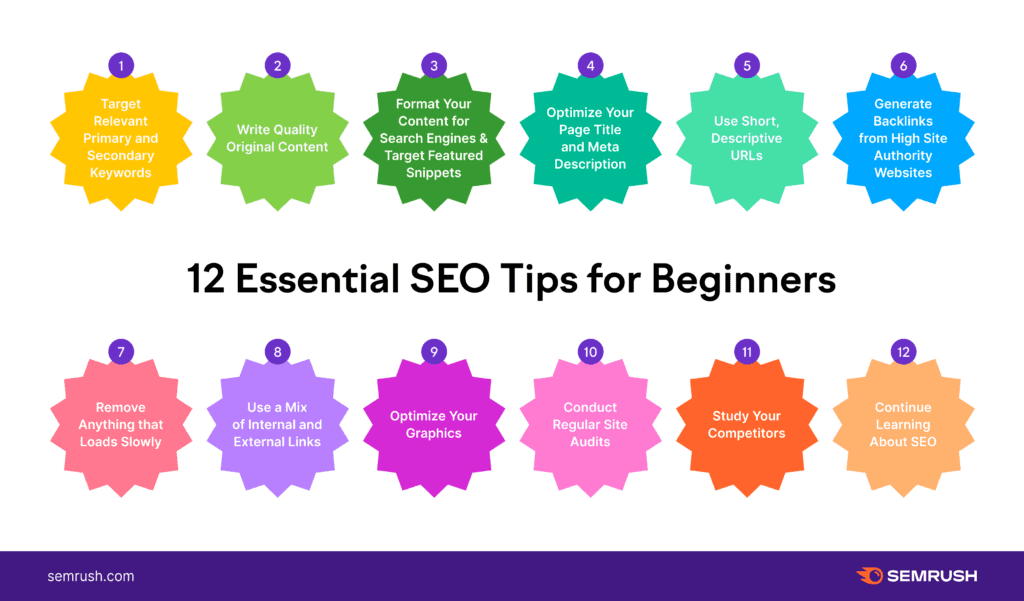
1. Identify your target audience
Figure out who your target audience is and what keywords they might use when searching for your products or services. Try to incorporate them into your content.
Research what kind of content and information your target audience is interested in. Providing content that your audience wants to consume can give you a slight advantage over competitors.
2. Conduct a basic website audit
Make sure your website is easy to navigate and understand.
Check that your website’s pages are correctly indexed by search engines.
3. Optimize your website content:
Use targeted keywords throughout your website, including in your page titles, headings, content, and meta descriptions.
Write high-quality content that is relevant and informative to your target audience.
Also, consider using images and videos to make your website more engaging.
4. Build backlinks
Reach out to other websites in your industry and ask them to link to your website.
You can also use social media to promote your content and build backlinks.
5. Monitor your SEO performance:
Regularly review and update your website’s content and keywords to maintain and improve your SEO performance.
FAQs
How to the start SEO of your website?
To do SEO for your website, start with doing keyword research and optimizing your website’s structure and content with relevant keywords.
Ensure that your website is mobile-friendly and build high-quality backlinks from reputable websites.
Regularly monitor and update your website with fresh, high-quality content to improve its visibility in search engine results.
How hard is SEO?
SEO can be challenging, especially for beginners who are not familiar with the technical aspects of the process. However, with the right resources and strategies, anyone can learn and implement effective SEO techniques for their website.
Do you need to know coding to do SEO?
While some technical aspects of SEO, such as website structure and optimization, may require some knowledge of HTML and CSS, many SEO techniques can be implemented without any coding experience. There are a variety of user-friendly SEO tools available that can help you optimize your website and content.
What is SEM? Is it the same as SEO?
SEM refers to paid search advertising. It involves running pay-per-click (PPC) campaigns, where advertisers bid on keywords and create ads that appear at the top or bottom of search results pages.
SEO, on the other hand, focuses on improving a website’s relevance and authority to rank higher in organic search results. Both SEM and SEO are important strategies for improving a website’s online visibility, but they use different methods to achieve their goals.
How long does it take for SEO to work?
The answer depends on several factors, such as the age of your website, the competitiveness of the keywords, and the quality of your content. In general, it can take a few weeks to several months before you start seeing results.
Lastly, is important to remember that SEO is a gradual process and may take anywhere from a few weeks to several months to see significant improvements in your search engine rankings and traffic. However, with consistent effort and monitoring, you can expect to see gradual improvements over time.

